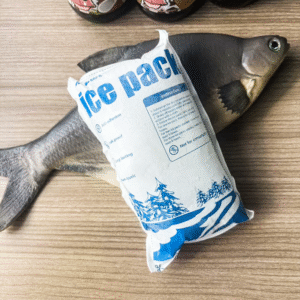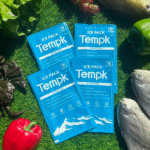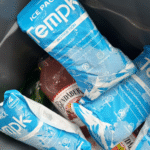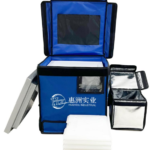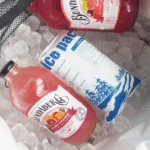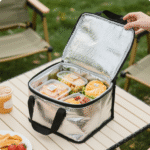Dry Ice Sleeve: How Do You Ship Safer in 2025?
Updated: August 19, 2025. A dry ice sleeve is your simple way to ship frozen goods with fewer temperature dips and fewer compliance headaches. Use a dry ice sleeve to keep CO₂ vented, reduce surface freeze-burn, and pass IATA PI 954 and USPS 9A checks. At –78.5 °C, dry ice is powerful; the sleeve helps you control it—safely, consistently, and at lower total cost.
-
How a dry ice sleeve works and why venting prevents ruptures (long‑tail: vented dry ice sleeve).
-
How to size a dry ice sleeve for 24–96‑hour lanes (long‑tail: dry ice sleeve sizing guide).
-
The 2025 compliance checklist for dry ice sleeve packouts (long‑tail: UN 1845 label, Class 9).
-
When to choose sleeves vs. bags, liners, or covers (long‑tail: CO₂ barrier sleeve vs kraft sleeve).
-
Practical tips, calculators, and a quick self‑check to reduce waste.
What is a dry ice sleeve—and why does venting matter?
A dry ice sleeve is a vented barrier that holds dry ice in place, prevents direct contact with your payload, and lets CO₂ escape. That vent path stops pressure build‑up, reduces “flash‑freeze” damage, and smooths cold delivery. Carriers enforce venting under IATA PI 954, and mail rules (USPS 9A) cap air mailpieces at 5 lb and require vented packaging. In short, pair the sleeve’s control with a clear gas‑release path to stay safe and compliant.
Why it works—plain English. Heat flows from your product to the dry ice. Without a sleeve, pellets or slabs can touch pouches and cartons, causing brittle spots and cold shocks. With a dry ice sleeve, you create a small, breathable gap that spreads cold more evenly and dampens super‑cooling dips if the box is tipped during transit. This simple spacer‑plus‑vent design improves stability without changing your shipper.
How a vented CO₂ barrier sleeve reduces super‑cooling
Key idea: a barrier sleeve with a top vent keeps internal pressure steadier when a shipper rides on its side, so temperatures swing less. Tests discussed in industry forums show smaller dips and slower sublimation when a vented overhang is used. That helps frozen foods and biologics ride out rough handling while staying within range.
| Sleeve Type (Use Case) | Typical Build | Vent Method | What it means for you |
|---|---|---|---|
| CO₂‑barrier sleeve around multipanel shippers | Poly barrier on 5–6 sides | Small top vent | Steadier temps when tipped; less super‑cooling. |
| Perforated kraft sleeve for food | Duplex kraft, stitched ends | Perforations/porosity | Simple, low‑cost, reduces surface freeze‑burn. |
| Corrugated wrap/spacer sleeve | Corrugate tube/wrap | Edge gaps | Easy positioning; ensure a clear vent path. |
Practical tips you can use today
-
Block management: Wrap slabs in a vented dry ice sleeve so they don’t weld to cartons or pierce pouches.
-
Whole‑carton sleeve: For EPS/VIP shippers, use a barrier sleeve with an overhang vent to moderate dips.
-
Reusables: For totes, insulated “sleeve‑like” covers cut daily sublimation during picks.
Real‑world case: Replacing an open wrap with a barrier sleeve plus overhang vent reduced temperature dips after tip/impact tests and extended hold time—without changing the shipper.
How do you size a dry ice sleeve for 24–96‑hour frozen lanes?
Start with lane duration, shipper class, and venting. Pre‑freeze the load, place dry ice above and around the payload inside a vented sleeve, and plan roughly 5–10 lb per 24 hours, adding 10–20% buffer for handoffs. Longer runs (72–96 h) favor barrier sleeves and higher‑performance insulation (e.g., VIP). Instrument one or two pilots before you scale.
Expand the plan. Use the sleeve to contain pellets/blocks and maintain a vent at the top. For parcel, keep marks on the same face: “Dry Ice” / “Carbon Dioxide, solid,” UN 1845, net kg + Class 9. For mail, keep air mailpieces ≤5 lb of dry ice. For pallets/ULD, coordinate venting with the operator. The dry ice sleeve stabilizes gas flow in all three contexts.
| Target Duration | Ambient Profile | Shipper Class | Sleeve + Dry Ice Rule | What to expect |
|---|---|---|---|---|
| 24–36 h | Mild (15–25 °C) | EPS molded | ~5 lb / 24 h in vented dry ice sleeve | Good for local/regional routes. |
| 48–72 h | Warm (25–30 °C) | EPS or PUR | 7–8 lb / 24 h; barrier sleeve if multipanel | Moderates super‑cooling if tipped. |
| 72–96 h | Hot (30–35 °C) | VIP/validated | 8–10 lb / 24 h; barrier sleeve + overhang vent | Higher stability on long lanes. |
Pocket calculator: 60‑second sleeve sizing
Safety quick‑check (don’t skip)
-
Vent every package; never seal a sleeve airtight. OSHA/NIOSH exposure limits: 5,000 ppm TWA, 30,000 ppm STEL—keep rooms/vehicles ventilated.
-
Wear insulated gloves and eye protection; avoid brittle, airtight liners at dry‑ice temperatures.
Dry ice sleeve compliance in 2025: what will carriers check?
Three things every time: venting, marks, and net weight. Air shipments under PI 954 need a package that releases gas, a Class 9 label, and text marks (“Dry Ice” / “Carbon Dioxide, solid,” UN 1845, net kg). FedEx job aids also warn: do not put dry ice in sealed plastic bags. USPS 9A limits air mailpieces to ≤5 lb of dry ice. A sleeve is fine—so long as the vent path stays open.
Pro tip: Place marks and the Class 9 label on the same face when space allows, and keep a label template by the packout station. For ULD/pallet use, confirm venting with the operator and record net kg in the load plan. The sleeve is a handling aid; compliance still lives on the outer box.
Dry ice sleeve vs. bag vs. insulated cover—which fits your job?
Quick map: A dry ice sleeve controls contact and gas flow around blocks inside the shipper. A paper/kraft bag contains pellets but must be porous. An insulated cover (sleeve‑like pad) drapes over chests/totes in operations to cut sublimation during frequent access. Mix layers as your scenario demands; just keep venting non‑negotiable.
Buyer’s table (choose by scenario)
| Scenario | Primary Layer | Where a dry ice sleeve helps | Your benefit |
|---|---|---|---|
| Frequent access to a chest/tote | Insulated container | Sleeve‑like cover over lid/opening during picks | Fewer top‑offs; safer handling. |
| Parcel, 24–72 h | Insulated shipper + vented inner | Wrap block in vented dry ice sleeve during packout | Buys time; reduces cold burns. |
| Pallet/ULD top‑cooling | Pallet cover | Stabilize blocks; keep vents clear | Smoother temps through door‑open events. |
Actionable tips
-
If you open a chest ≥6×/hour, add a sleeve‑like cover; if not, invest in shipper insulation first.
-
For multipanel shippers, prefer a barrier sleeve with a top vent.
2025 trends in dry ice sleeve design and monitoring
What’s new this year: carrier acceptance checklists are clearer, USPS 9A limits remain in force, and barrier sleeves with vented overhangs are gaining adoption to tame super‑cooling when boxes tip. More vendors now offer sleeves with woven handles and ID windows, and route monitoring with BLE/cellular loggers is becoming standard. All of this plays nicely with a compliant dry ice sleeve workflow.
Latest progress at a glance
-
Vented barrier geometry: Higher vent placement = steadier pressure if the shipper rides on its side.
-
Operations sleeves: Reusable covers cut sublimation during dock picks; better ergonomics with grab handles.
-
Clearer checklists: Fewer avoidable rejections at induction (label sizes, mark placement).
Market insight: Prequalified dry‑ice systems (5–106 L) now claim 96–120 h under warm profiles thanks to better gas management. Strategically adding a sleeve is a low‑cost lever to improve stability without changing your shipper or SOP.
Frequently Asked Questions about dry ice sleeves
How long will a dry ice sleeve keep items frozen?
In a qualified shipper, expect ~48–96 hours depending on insulation, load mass, and ambient profile. Start at 5–10 lb per 24 h and validate with a data logger.
Can I seal a dry ice sleeve to trap cold?
No. Never seal dry ice; packages must vent CO₂. FedEx explicitly forbids sealed plastic bags with dry ice.
Is a dry ice sleeve allowed by air and mail carriers?
Yes—if the package vents gas and is properly marked (UN 1845, Class 9, net kg). USPS 9A caps air mailpieces at 5 lb.
How much gas does dry ice produce?
About 8.3 cubic feet per pound of CO₂—reason enough to keep rooms and vehicles ventilated.
Do sleeves replace PPE?
No. Use insulated gloves/eye protection; keep vents open; follow OSHA/NIOSH 5,000 ppm TWA / 30,000 ppm STEL guidance.
Summary & next steps
Takeaways: A dry ice sleeve adds a vented buffer that protects product surfaces, smooths temperature, and helps you pass acceptance on the first try. Size dry ice at 5–10 lb per 24 h, mark UN 1845 and net kg with a Class 9 label, and keep every vent path clear. Instrument, pilot, and then standardize.
About Tempk
We design validated cold‑chain packouts for frozen and deep‑frozen lanes. Our engineers right‑size dry ice sleeve strategies, dry ice mass, and insulation using lane data, then document PI 954/USPS‑ready labels and SOPs so your team passes acceptance the first time. Customers report steadier temps, fewer QA holds, and lower dry ice spend.
Talk to an engineer: Book a 30‑minute consult to select your dry ice sleeve, labels, and a lane‑specific test plan this week.






